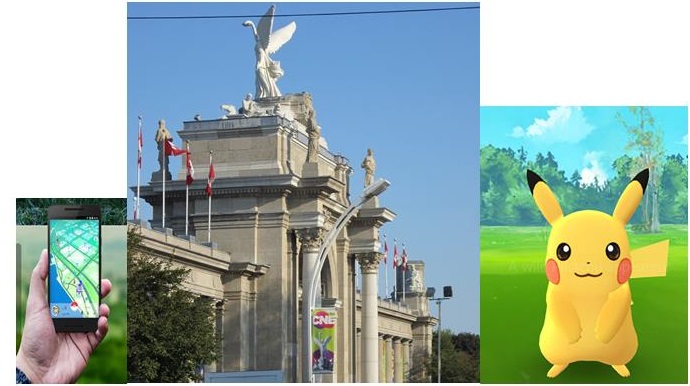At last the the nostalgic fun of the CNE decends upon Toronto once more. Weired food like maple bacon and vanilla ice cream sandwiched in a croissant and flour tortilla tacos with chipotle fried beef sirloin and toasted crickets, family-friendly rides, and of course Pokemon hunting. Pokemon hunting?
Yup, you heard it right the Canadian National Exhibition has become a hotbed of Pokemons as the exhibition organizers jumped onto the Pokemon Go bandwagon dropping lures all over the grounds and offering CNE guests prizes for catching Pokemons.
While many facilities and businesses might have dismissed Pokehunters as a nuisance and have even barred them from their premises, Canada’s largest, and 138-year-old fair, is embracing them. And in so doing, probably found a way of making good use of the millennial-powered, augmented reality, mobile craze.
The CNE opens tomorrow! ? @Jazzy_Photos #LetsGoToTheEx pic.twitter.com/OAafyOodrG
— Norm Kelly (@norm) August 18, 2016
“We’re really not out to benefit from Pokemon Go,” says Cameron Gallant, advanced sales and community relations assistant for the CNE. “It’s a fun game and we just thought it would be really fun for our guests.”
Pokemon Go of course is that addictive free-to-play, location-based, AR game developed by by Niantic for iOS and Android devices and released this July. Players use their smartphone’s GPS features to locate, capture, train, and battle virtual Pokemon creatures that appear on their device’s screens.
According to Gallant, it just so happens that the CNE grounds near Toronto’s lakefront is a teeming with Pokestops or locations where it’s possible to find those cuddly Japanese cartoon characters.
There are four Pokegyms and 31 Pokestops in the CNE grounds he said. Actually, there are more than 31 stops but some of them are in construction areas, so they have been cordoned off.
Narcity: “If You Want To Catch Pokémon, You’re Going To Want To Go To The CNE This Year” https://t.co/At6w6I7XUl via @NarcityToronto
— CNE (@LetsGoToTheEX) August 17, 2016
“A bunch of us (CNE personnel) were already playing the game here ever since we discovered the Pokestop,” Gallant said. “From there, the idea of incorporating Pokemon Go to the CNE activities developed.”
To add to the excitement, CNE purchase Pokemon lures from the game’s developer Niantic. Lure modules are applications that are meant to attract Pokemons into a certain PokeStop. This makes it easier for hunters to catch Pokemons. However, the lures only last for 30 minutes.
Then CNE tied the game to their social media outlets, announcing to guests that they were offering free CNE tickets to people that caught Pokemons in the CNE grounds and tweeted the screen capture of the creatures to the CNE social media accounts. CNE also used their Facebook and Tweeter accounts to announce when and where the lures were being laid.
This is a great example of how businesses and even government organizations might be able to take advantage of mobile-based augmented reality technology such as Pokemon Gon, according to Varun Chhabra, head of product marketing, for the Advanced Software Division at the big data and cloud company EMC Corp.
The money-making potential of Pokemon Go is astounding. Some of the numbers being thrown around are 21 million daily active users; 700,000 downloads each day, and $3 million in-app purchase each day,
There have been media reports that Pokemon Go has the potential of earning more than $1.9 billion due to in-app purchases for its owner and the game could be worth more than $29 billion when you figure in potential ad revenues, according to MoneyNation.com.
“Then, there is the matter of user data collected from Pokemon Go players,” said Chhabra. “I have no idea how Niantic or Nintendo is using this information or making money out of it.”
However, he said information from mobile devices could be very useful for businesses that may have Pokemon Go action happening around their location.
With the proper analytics tools, an organization, for example, can find out what demographics of people frequent a certain area at a certain time.
Information like this can be valuable for the retail or grocery industry, where the location of merchandize within a store is critical to profits.
Chhabra said, augmented reality and GPS-based mobile applications like Pokemon Go can help businesses “enhance customer experience” while gathering customer data at the same time.
“Imagine a mobile app which lets customers take a smartphone picture of a grocery aisle and immediately tells the user which product he or she previously purchased from that section and perhaps even offer a special offer price on other items to that customer,” said Chhabra.”Maybe that app can also help the customer find items that they are looking for.”
All the while, the customer’s mobile device could be sending back data to the store about the customer’s location and purchase choices.
Then, of course, there is the fun factor.
Stores and facilities could just offer customers an opportunity to play a game like Pokemon Go, Just like what CNE is doing.
12pm Lure drop | Tweet screen cap at Ricoh & Hall C+D. Use #PokemonCNE for a chance to win! #CNE2016 pic.twitter.com/J8WB75SlnY
— CNE (@LetsGoToTheEX) August 19, 2016
Gallant said, it actually cost CNE almost nothing to host its Pokemon hunt. Their main expense involved purchasing Pokemon lures. An 8-pack of Pokemon lures costs 680 Pokemon coins, and 2500 coins cost around $27.99.
There are other businesses cashing in on the Pokemon Go craze like the 24/7 Pokémon Go bus driving around New York charging riders $0.99 per Pokestop, $24.99 to take over a gym and $49.99 for hatching a Pokemon egg.
For other cool ways of joining the Poke Economy, click on this link the Mashable article by Emma Hinchliffe.

